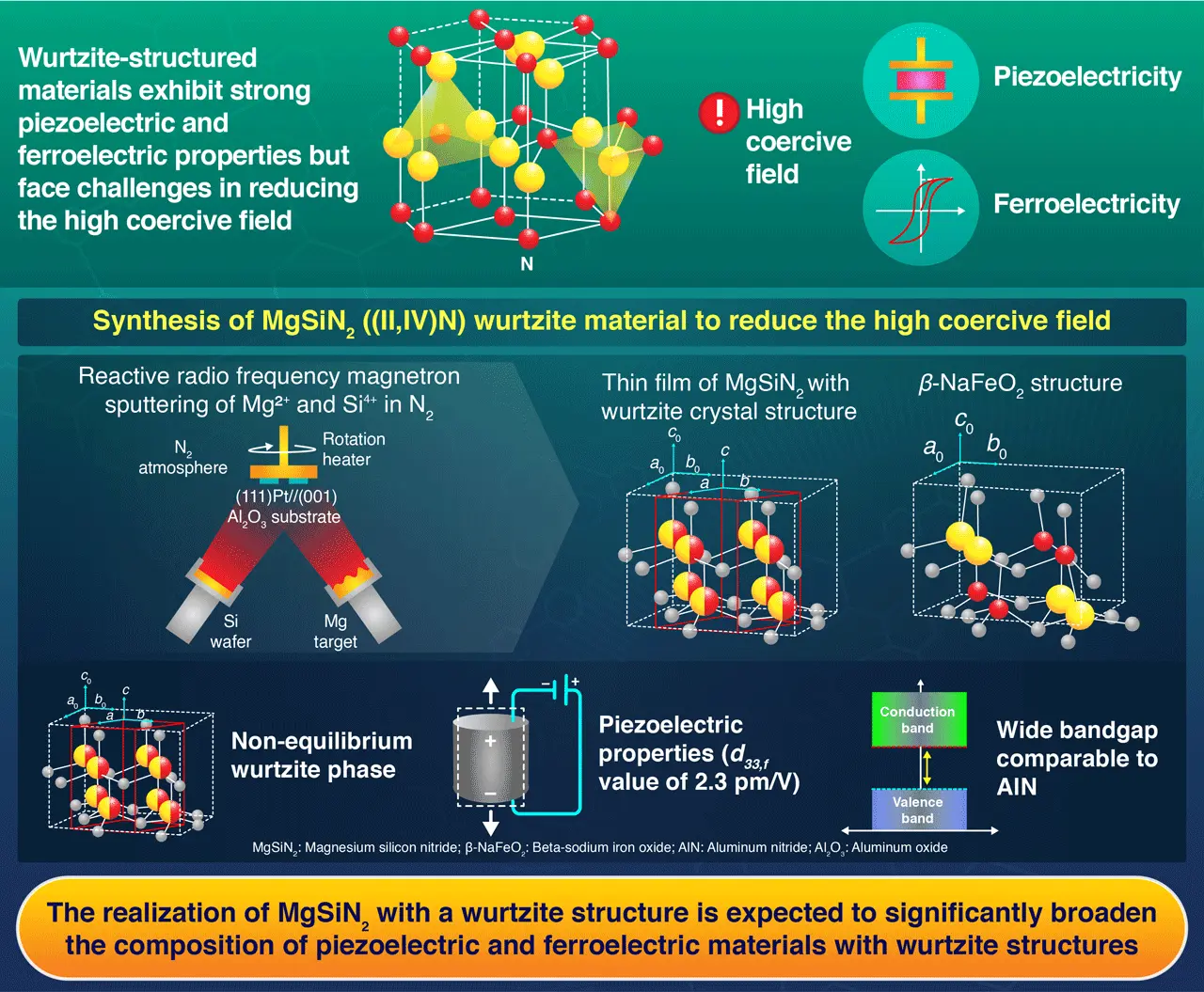From Structure to Function: Tailoring Wurtzite MgSiN₂ for Next-Generation Electronics
Researchers develop first-ever wurtzite-structured MgSiN₂ thin films, unlocking new possibilities for piezoelectric and ferroelectric applications
Nitrides with a wurtzite structure are widely used in cutting-edge technologies, from blue light-emitting diodes to high-frequency noise filters in smartphones. Now, for the first time, scientists from Institute of Science Tokyo have successfully synthesized a wurtzite-structured MgSiN2 thin film, an insulating nitride containing two elements. This material exhibits compatible optical and piezoelectric properties, paving the way for new energy conversion materials, ferroelectric memory, and next-generation electronic devices.
Synthesis of Non-Equilibrium Wurtzite Structured MgSiN2 Thin Films

Kageyama et al. (2025) | Advanced Electronic Materials | DOI: 10.1002/aelm.202400880
Wurtzite-structured crystals, characterized by their hexagonal symmetry, are widely valued for their unique electronic and piezoelectric properties—their ability to generate an electric charge when subjected to mechanical stress. Among these, gallium nitride (GaN), a key material in blue light-emitting diodes, and aluminum nitride (AlN), used in high-frequency radio frequency (RF) filters in smartphones, are prominent examples. These materials play a crucial role in advanced semiconductors, sensors, and actuators.
Scientists at Institute of Science Tokyo (Science Tokyo), Japan, have made a significant breakthrough in expanding the wurtzite structure to include heterovalent ternary nitrides, specifically for potential piezoelectric and ferroelectric applications. Their paper, which was made available online on February 6, 2025, in Advanced Electronic Materials, describes the fabrication of the first-ever magnesium silicon nitride (MgSiN2) heterovalent nitride in a wurtzite structure with piezoelectric properties. This pioneering study was led by Professor Hiroshi Funakubo from MDX Research Center for Element Strategy, Science Tokyo, in collaboration with Mr. Sotaro Kageyama, a second-year Master's student, Assistant Professor Kazuki Okamoto, and Professor Hiroko Yokota from the School of Materials Science and Engineering, Science Tokyo. The research team also included Professor Venkatraman Gopalan from Pennsylvania State University, Associate Professor Yoshiomi Hiranaga from Tohoku University, Professor Hiroshi Uchida from Sophia University, and others.
Wurtzite structures, such as AlN and GaN, are usually made of trivalent cations. However, these materials face challenges due to high coercive electric fields—the energy required to switch polarization for piezoelectric charge generation and ferroelectric properties. Incorporating heterovalent cations with valencies of II/IV alters the structural rigidity due to differences in cation radii. This alteration has been shown to facilitate polarization and lower the coercive field. To explore this effect, the researchers selected the heterovalent ternary nitride MgSiN2, composed of Mg2+ and Si4+.
MgSiN2 typically crystallizes in the orthorhombic β-NaFeO2 structure. However, the research team successfully stabilized it in a wurtzite phase using reactive RF magnetron sputtering of Mg and Si ions at 600 °C in a nitrogen-rich atmosphere. This structural transformation introduced a random cationic ordering.
“The ability to synthesize MgSiN2 in a new wurtzite phase is a major advancement in the field of piezoelectric materials,” explains Funakubo. “Our findings could open new avenues for developing high-performance materials with tailored electronic properties.”
The results confirmed the piezoelectric nature of wurtzite-MgSiN2 using advanced characterization techniques, including X-ray diffraction, transmission electron microscopy, and piezoresponse force microscopy. The fabricated material exhibited a converse piezoelectric coefficient (d33,f = 2.3 pm/V) comparable to those of conventional simple nitrides, indicating its ability to effectively convert mechanical stress into electric charge. This breakthrough creates potential applications in ultrasonic transducers, nanoelectromechanical systems, and energy harvesters.
The piezoelectric MgSiN2 exhibited a wide bandgap of approximately 5.9 eV (direct) and 5.1 eV (indirect), comparable to traditional piezoelectric wurtzite AlN. This suggests that the material provides excellent insulation by restricting electron movement between the valence band (where electrons are bound to atoms) and the conduction band (where electrons are free to move and conduct electricity). A wider bandgap indicates strong resistance to electrical conduction under normal conditions, confirming the material’s durability and stability. These properties make MgSiN2 a promising candidate for next-generation electronics.
“Our research lays the foundation for further exploration of heterovalent ternary nitrides with piezoelectric properties. Fine-tuning the deposition parameters could lead to greater improvements in polarization switching and further validate the material’s ferroelectric properties,” concludes Funakubo.
As the researchers continue to investigate new material phases for piezoelectric applications, the wurtzite-structured MgSiN2 emerges as a promising candidate for next-generation piezoelectric and ferroelectric technologies, paving the way for advancements in electronic materials.
Reference
- Authors:
- Sotaro Kageyama1, Kazuki Okamoto1, Shinnosuke Yasuoka1, Keisuke Ide2, Kota Hanzawa3, Yoshiomi Hiranaga4, Pochun Hsieh5, Sankalpa Hazra5, Albert Suceava5, Akash Saha5, Hiroko Yokota1, Kei Shigematsu3, Masaki Azuma3, Venkatraman Gopalan5, Hiroshi Uchida6, Hidenori Hiramatsu2,3, and Hiroshi Funakubo2
- Title:
- Realization of Non-Equilibrium Wurtzite Structure in Heterovalent Ternary MgSiN2 Film Grown by Reactive Sputtering
- Journal:
- Advanced Electronic Materials
- Affiliations:
- 1School of Materials Science and Engineering, Institute of Science Tokyo, Japan
2MDX Research Center for Element Strategy, Institute of Integrated Research, Institute of Science Tokyo, Japan
3Materials and Structures Laboratory, Institute of Integrated Research, Institute of Science Tokyo, Japan
4Research Institute of Electrical Communication, Tohoku University, Japan
5Materials Research Institute and Department of Materials Science, Pennsylvania State University, USA
6Graduate School of Science and Technology, Sophia University, Japan
Related articles
Further Information
Professor Hiroshi Funakubo
Institute of Integrated Research, Institute of Science Tokyo
Assistant Professor Kazuki Okamoto
School of Materials Science and Engineering, Institute of Science Tokyo
Contact
Public Relations Division, Institute of Science Tokyo
- Tel
- +81-3-5734-2975
- media@adm.isct.ac.jp